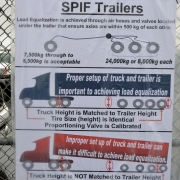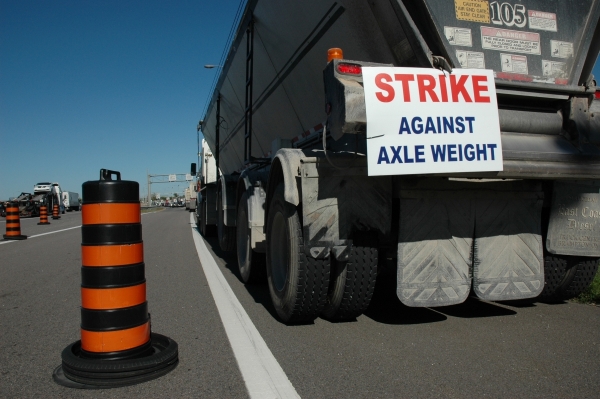Gravel haulers protest axle weight crackdown

MILTON, ON – A longstanding dispute around allowable axle weights has boiled to the surface, with dozens of aggregate haulers occupying three Ontario Ministry of Transportation scales in the Toronto area.
The protesters began parking their equipment at 2 a.m. on September 20 in the facility adjacent to the eastbound lanes of Highway 401 near Trafalgar Road in Milton, Ontario. They returned on Wednesday and pledged to expand the protest at nearby quarries. Some had already been protesting around sites in Aberfoyle and Dundas, Ontario.
 “We just want a solution,” said Jagroop Singh Bangli, a two-truck owner-operator who was involved in organizing the fight, as he divided his peers into teams for the next stage of the protest. “We don’t want to take any more tickets.”
“We just want a solution,” said Jagroop Singh Bangli, a two-truck owner-operator who was involved in organizing the fight, as he divided his peers into teams for the next stage of the protest. “We don’t want to take any more tickets.”
The issue can be traced to a harder line on axle weight tolerances that began on September 1, after several years of soft enforcement and education programs relating to the province’s Safe, Productive and Infrastructure-Friendly (SPIF) rules for weights and dimensions.
“When we go to the pits and get loaded, we don’t know how much they’re loading, how they are loading us,” says Manny Singh, a driver based in Brampton, Ontario. While the quarry operators escape unscathed, those who run the trucks face tickets, fines and unwanted points on Commercial Vehicle Operator Registration (CVOR) records, he stressed.
Many of the troubles involve those who are repurposing used highway tractors to haul gravel. Steer axles can’t take enough weight. Mismatched fifth wheel heights won’t allow the loads to equalize, and self-steering axles are often undersized. To compound matters, the Ontario Ministry of Labor is called if drivers attempt to redistribute the loads with shovels.
 Ontario Ministry of Transportation enforcement teams have reportedly been allowing those with axle weight violations to pull behind the scale and try to equalize loads by adjusting equipment or calling mechanics. Only if the trucks failed during a second pass over the scale were the drivers issued printed tickets.
Ontario Ministry of Transportation enforcement teams have reportedly been allowing those with axle weight violations to pull behind the scale and try to equalize loads by adjusting equipment or calling mechanics. Only if the trucks failed during a second pass over the scale were the drivers issued printed tickets.
The education programs included meetings at the Trafalgar scales in 2012 to show operators what they had to do to ensure trucks complied with the latest rules. Posters were also attached to the fence at the time to explain how maximum gross weights had to be distributed.
Ongoing meetings have yet to find common ground, with many of the truck operators insisting that they should enjoy more leeway in axle weights.
“It’s not realistic because we have no control over it,” Singh says of the focus on axle weights. “We have control over gross weight. If we are doing that, it should be enough.”
– More information about the protest, including support from aggregate producers themselves, is available here.

Have your say
This is a moderated forum. Comments will no longer be published unless they are accompanied by a first and last name and a verifiable email address. (Today's Trucking will not publish or share the email address.) Profane language and content deemed to be libelous, racist, or threatening in nature will not be published under any circumstances.